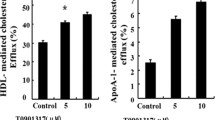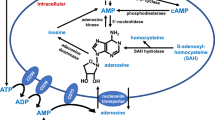Abstract
Statins have both cholesterol lowering and anti-inflammatory activities, whether mechanisms underlying their activities are independent remains unclear. The ATP-gated P2X4 receptor is a pro-inflammatory mediator. Here, we investigate the action of fluvastatin and other cholesterol depleting agents on native and recombinant human P2X4 receptor. Fluvastatin and mβCD suppressed P2X4-dependent calcium influx in THP-1 monocytes, without affecting P2Y receptor responses. mβCD or filipin III suppressed the current density of recombinant human P2X4 receptors. Human P2X2 was insensitive to cholesterol depletion. Cholesterol depletion had no effect on intrinsic P2X4 receptor properties as judged by ATP concentration–response relationship, receptor rundown or current decay during agonist occupancy. These data suggest fluvastatin suppresses P2X4 activity in monocytes through cholesterol depletion and not by modulating intrinsic channel properties.




Similar content being viewed by others
Abbreviations
- MβCD:
-
Methyl-β-cyclodextrin
References
Scandinavian Simvastatin Survival Study Group (1994) Randomised trial of cholesterol lowering in 4444 patients with coronary heart disease: the Scandinavian Simvastatin Survival Study (4S). Lancet 344:1383–1389
Scalia R et al (2001) Simvastatin exerts both anti-inflammatory and cardioprotective effects in apolipoprotein E-deficient mice. Circulation 103:2598–2603
Pruefer D et al (2002) Simvastatin inhibits inflammatory properties of Staphylococcus aureus α-toxin. Circulation 106:2104–2110
Østerud B, BjÈ-Rklid E (2003) Role of monocytes in atherogenesis. Physiol Rev 83:1069–1112
North RA (2002) Molecular physiology of P2X receptors. Physiol Rev 82:1013–1067
Wang L, Jacobsen SE, Bengtsson A, Erlinge D (2004) P2 receptor mRNA expression profiles in human lymphocytes, monocytes and CD34+ stem and progenitor cells. BMC Immunol 5:16
Qureshi OS, Paramasivam A, Yu JCH, Murrell-Lagnado RD (2007) Regulation of P2X4 receptors by lysosomal targeting, glycan protection and exocytosis. J Cell Sci 120:3838–3849
Sim JA, Park CK, Oh SB, Evans RJ, North RA (2007) P2X1 and P2X4 receptor currents in mouse macrophages. Br J Pharmacol 152:1283–1290
Tsuda M, Shigemoto-Mogami Y, Koizumi S, Mizokoshi A, Kohsaka S, Salter MW, Inoue K (2003) P2X4 receptors induced in spinal microglia gate tactile allodynia after nerve injury. Nature 424:778–783
Ulmann L, Hirbec H, Rassendren F (2010) P2X4 receptors mediate PGE2 release by tissue-resident macrophages and initiate inflammatory pain. EMBO J 29:2290–2300
Priel A, Silberberg SD (2004) Mechanism of ivermectin facilitation of human P2X4 receptor channels. J Gen Physiol 123:281–293
Fountain SJ, North RA (2006) A C-terminal lysine that controls human P2X4 receptor desensitization. J Biol Chem 281:15044–15049
Wareham K, Vial C, Wykes RCE, Bradding P, Seward EP (2009) Functional evidence for the expression of P2X1, P2X4 and P2X7 receptors in human lung mast cells. Br J Pharmacol 157:1215–1224
Vial C, Evans RJ (2005) Disruption of lipid rafts inhibits P2X1 receptor-mediated currents and arterial vasoconstriction. J Biol Chem 280:30705–30711
Allsopp RC, Lalo U, Evans RJ (2010) Lipid raft association and cholesterol sensitivity of P2X1-4 receptors for ATP. J Biol Chem 285:32770–32777
Liu M, Huang W, Wu D, Priestley JV (2006) TRPV1, but not P2X3, requires cholesterol for its function and membrane expression in rat nociceptors. Eur J Neurosci 24:1–6
Jones CA, Chessell IP, Simon J, Barnard EA, Miller KJ, Michel AD, Humphrey PPA (2000) Functional characterization of the P2X4 receptor orthologues. Br J Pharmacol 129:388–394
Barth K, Weinhold K, Guenther A, Linge A, Gereke M, Kasper M (2008) Characterization of the molecular interaction between caveolin-1 and the P2X receptors 4 and 7 in E10 mouse lung alveolar epithelial cells. Int J Biochem Cell Biol 40:2230–2239
Hillyard DZ, Jardine AG, McDonald KJ, Cameron AJM (2004) Fluvastatin inhibits raft dependent Fc[gamma] receptor signalling in human monocytes. Atherosclerosis 172:219–228
Acknowledgements
This work was supported by the Biotechnology and Biological Sciences Research Council (BBSRC). SJF is generously supported by a BBSRC David Phillips Fellowship Award.
Author information
Authors and Affiliations
Corresponding author
Rights and permissions
About this article
Cite this article
Li, J., Fountain, S.J. Fluvastatin suppresses native and recombinant human P2X4 receptor function. Purinergic Signalling 8, 311–316 (2012). https://doi.org/10.1007/s11302-011-9289-9
Received:
Accepted:
Published:
Issue Date:
DOI: https://doi.org/10.1007/s11302-011-9289-9




